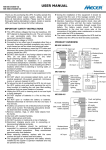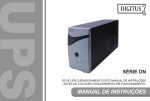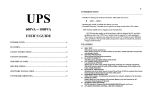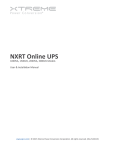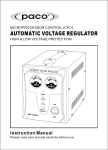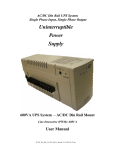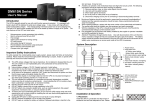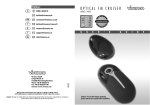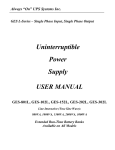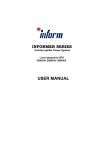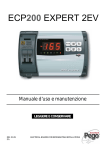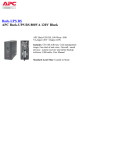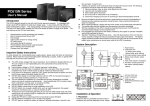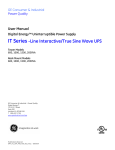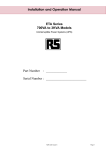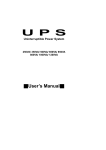Download IMPORTANT SAFETY INSTRUCTIONS SAVE THESE INSTRUCTIONS
Transcript
U P U n i n t e r r u p t i b l e P o w e r S S y s t e m 500VA/ 650VA/ 800VA User’s Manual IMPORTANT SAFETY INSTRUCTIONS SAVE THESE INSTRUCTIONS ●WARNING (SAVE THESE INSTRUCTIONS): This manual contains important instructions that should be followed during installation and maintenance of the UPS and batteries. ●WARNING (Controlled Environment) : Intend for installation in a controlled environment. ●CAUTION: Do not dispose of batteries in a fire, the battery may explode. ●CAUTION: Do not open or mutilate the battery, released electrolyte is harmful to the skin and eyes. It may be toxic. ●CAUTION: A battery can present a risk of electric shock and high short circuit current. The following precaution should be observed when working on batteries Remove watches, rings or other metal objects. Use tools with insulated handles. Wear rubber gloves and boots. Do not lay tools or metal parts on top of batteries. Disconnect charging source prior to connecting or disconnecting battery terminals. ●Servicing of batteries should be performed or supervised by personnel knowledgeable of batteries and the required precautions. Keep unauthorized personnel away from batteries. ●When replacing battery, replace with same type. ●Do not to addition battery for UPS. TABLE OF CONTENTS INTRODUCTION………………………………………………………….……………………………..1 IMPORTANT S AFETY INSTRUCTIONS………………………………………………………..………1 1. PRESENTATION………………...………….……………………………..…,.………………………2 2. INSTALLATION….………………………………………………………...…………………………3 3. OPERATION………………………………………………………………...………………………3 4. ALARMS………………………….….…………………………………………..……………………3 5. SOFTWARE AND INTERFACE PORT…………………………………………………………………4 APPENDIX A TROUBLESHOOTING……………………………………...……………..…………………5 APPENDIX B SPECIFICATIONS……..…………………………………...……………..………………5 Please read and save this manual ! Thank you for selecting this uninterruptible power system (UPS). It provides you with a perfect protection for connected equipment. The manual is a guide to install and use the UPS. It includes important safety instructions for operation and correct installation of the UPS. If you should have any problems with the UPS, please refer to this manual before calling customer service. 1 1. PRESENTATION The UPS is a standby uninterruptible power system (UPS). When utility input is normal, the UPS would provide surge protection and energy to charge the internal battery. If the utility input is abnormal, the UPS can supply AC power to the load immediately. (1). Utilizes microprocessor based controls, it will minimizes the dependency on hardware. Beside this, it maximizes system flexibility and optimizes the assurance of reliability. (2). Automatic frequency selection to match with utility power. (3). Hi-grade battery charger to prolong battery’s life and fully charge the battery. (4). With actual overload protection both in line and battery mode. Front View POW ER OVER LOAD BATT CHECK ON/OFF/TEST BAZZER STOP 1.1 “POWER” indicator (Green): The indicator will illuminate when the utility input is normal. The light becomes flash when working at back-up mode. 1.2 “OVERLOAD” indicator (Red): The indicator will illuminate when the output power is overload from the unit. 1.3 “BATTY” indicator (Red): The indicator illuminates when the battery is no longer useful and must be replaced. 1.4 “ON/OFF/TEST” button: No matter the UPS is plugged in or not. Press the “ON/OFF/TEST” button till the beep stop to turn on or turn off the UPS. It also enables the UPS self-test by press the bottom less than 1 second. 1.5 “BUZZER STOP” button In back up mode, press the bottom about 1 second to enable the UPS silence function. Rear View 1.6 Outlet Socket 1.7 Communication Port* 1.8 Internet/Tel/Modem Port* 1.9 Bypass Outlet (U.S. socket only) 1.10 Input Fuse 1.11 AC Input *Can be removed if not desired 2 2. INSTALLATION 2.1 Inspection: Inspect the UPS upon receipt. The packaging is recyclable; save it for reuse or dispose of it properly. 2.2 Placement: Install the UPS in controlled area with adequate air flowing and free of excessive dust. Do not operate the UPS at outdoor area. 2.3 Utility Power: The input power cord needs to connect the rear inlet socket of the UPS and plug into a socket on the wall. Please notice the voltage of utility power should match with the UPS. (For example, the rating voltage of UPS is 110V/(220V), the input utility power should be the same as 110V/(220V) .) 2.4 Connection: The employed equipment’s power cords (such as computer) are plugged into the sockets on the rear panel. Attention: Service personnel installable. Attention: With the installation, the overall leakage current of the UPS connected consumer shall not exceed 3.5mA. Attention: A block diagram of this unit is attached to the user’s manual and to the installation instruction. 3. OPERATION 3.1 Switch on: When utility input is connected to the UPS, press “ON” button at “OFF” mode and keep pressing until the beep stops. After that, connect the electrical cords of the equipment that is going to be used such as computer or monitor with the terminal at the rear panel of UPS. Attention: This unit is to operate by any individuals with previous training. Attention: At “BACKUP” mode, UPS can be automatically turned off if none of the connected loads is operating. (No Load shut down function) CAUTION: Never connect a laser printer or plotter to the UPS with other computer equipment. A laser printer or plotter periodically draws significantly more power than its idle status, and may overload the UPS. 3.2 Switch off: Press the “OFF” button at “LINE” or “BACKUP” modes and keep pressing more than 1 second to turn off the UPS. 3.3 Silence: When UPS is under “BACKUP” mode, press the “BUZZER STOP” button about 1 second to silence the audible alarm. (The function is disabled when UPS is under condition of “LOW BATTERY” or “OVERLOAD”) 3.4 Self-test function: Press the “TEST” button at “LINE” mode about 1 second, UPS will perform self-test procedure automatically. 4. ALARM 4.1 “BACKUP” (slow alarm): When the UPS is working under “BACKUP” mode, the UPS would emit audible alarm. The alarm stops when the UPS is return to “LINE” mode operation. Attention: The alarm of “BACKUP” is going to beep every 2 seconds. (Slow-speed beep). Attention: The UPS provides mute function for the warning. When the beeping sound occurs, press "BUZZER STOP" to stop it; and press "BUZZER STOP" again to resume the sound. 3 4.2 “LOW BATTERY” (rapid alarm): In the “BACKUP” mode, when the energy of battery becomes to lower level. (about 20%~30%) The UPS beeps rapidly until the UPS shuts down from battery exhaustion or returns to “LINE” mode operation. Attention: The alarm of the batteries caused by low voltage beeps every 0.5 second. Attention: The rapid alarm under “LOW BATTERY” condition cannot be muted. 4.3 “OVER LOAD” (continuous alarm): When the UPS is working under overload condition (the connected loads exceed the maximum rated capacity), the UPS will emit continuous alarm to warn an overload condition. In order to protect the unit and the loads, the UPS will be automatic turn off. Please disconnect nonessential devices from UPS to eliminate the overload alarm. 5. S OFTWARE AND I NTERFACE P ORT 5.1 Power Monitoring Software The UPS-MON series software (or other power monitoring software) is applied standard RS-232 interface to perform monitoring functions, and then provides an orderly shutdown of a computer in the event of power failure. Moreover, UPS-MON displays all the diagnostic symptoms on monitor, such as Voltage, Frequency, Battery level and so on. The software is available for DOS, Windows 3.1x, Windows 95, Windows 98, Windows NT V3.5 or later, Novell Netware, Linux, and others. Call your dealer for more information on computer OS compatible solutions. 5.2 Interface Kits A series of interface kits is available for operation systems that provide UPS monitoring. Each interface kit includes the special interface cable required to convert status signals from the UPS into signals which individual operating system recognizes. The interface cable at UPS side must be connected to REMOTE PORT, at computer side can be either COM 1 or COM 2. The other installation instructions and powerful features please refer to READ.ME file. CAUTION: Use only factory supplied or authorized UPS monitoring cable! 5.3 The characteristics of computer interface port The computer interface port has the following characteristics: The communication port on the back of the UPS may be connected to host computer. This port allows the computer to monitor the status of the UPS and control the operation of the UPS in some cases. Its major functions normally include some or all of the following: To broadcast a warning when power fails. To close any open file before the battery is exhausted. To turn-off the UPS. Some computers are equipped with a special connector to link with the communication port. In addition, special plug-in cord may be needed. Some computers may need special UPS monitoring software. Contact your dealer for the details on the various interface Kits. 4 APPENDIX A TROUBLESHOOTING PROBLEM POSSIBLE CAUSE UPS cannot turn ON/OFF/TEST/SILENCE button on not pushed or push-time too LED not light short Battery voltage less than 10V PCB failure Load less than 20W at battery mode UPS always at Power cord lose battery mode AC FUSE burn out Line voltage too high, too low or black out PCB failure Back up time too battery not fully charged short PCB failure Buzzer continuous Overload beeping ACTION TO TAKE Press the ON/OFF/TEST/SILENCE button more than 1 second Recharge the ups at least 6 hours Replace the PCB, call for service Normal condition, “No load shutdown function” is active. Plug in the power cord Replace the AC fuse Normal condition Replace PCB, call for service Recharge the UPS at least 6 hours Replace PCB, call for service Remove some loads APPENDIX B. SPECIFICATIONS OUTPUT MODEL Capacity Bypass Capacity No. of sockets Voltage (on battery) Frequency(on battery) Transfer Time INPUT Voltage(single phase) PROTECTION Frequency Unit Input Overload Protection Short Circuit 500 650 800 500VA 650VA 800VA 300VA 300VA 300VA T wo U P S S o c k e t s a n d O n e B y p a s s Socket S i m u l a t e d s i n e wa v e a t 100V/110V/115V/220V/240V +/-5% 50 or 60Hz +/-0.3Hz 2/4 milliseconds, including detection time 110V+20%/-15% at line input, 110V/115V/+/-20% at line input 220V+/-25% at line input, 240V+15%/-20% at line input 50 or 60Hz+/-10% ( auto sensing) Fuse for overload & short circuit protection U P S a u t o m a t i c s h u t d o wn i f o v e r l o a d e xc e e d s 1 0 5 % o f n o m i n a l a t 2 0 seconds, 120% at 10 seconds, 130% at 3 seconds UPS output cut off immediately 5 BATTERY Type Sealed, maintenance-free lead acid b a t t e r i e s , wi t h 3 - 6 y e a r s t y p i c a l l i f e t i m e Battery Check LED Indicators Typical Recharge Time (to 90% of full capacity) Back up Time (minutes) ( P C wi t h 1 5 ” m o n i t o r ) Protection PHYSICAL N e t we i g h t K g ( l b s ) D i m e n s i o n ( m m ) W xD xH INTERFACE Dry contact RS232 ALARM Battery Back-Up Battery Low 105% load Overload ENVIRONMENT Ambient operation Audible Noise 4 hours 10-25 15-30 18-33 minutes minutes minutes Automatic self-test, Over discharge protection, short circuit protection by fuse 3.6(7.9) 3.7(8.1) 3.8(8.3) 70*297*195 (2.8*11.7*7.7) S e n d s b a t t e r y l o w & p o we r f a i l u r e s i g n a l s , a n d r e c e i v e s s h u t d o wn s i g n a l from computer D e t e c t b a t t e r y l o w, S c h e d u l e U P S o n / o f f , A S i n p u t / o u t p u t p o we r s t a t u s display Slow beeping sound every 4 seconds(buzzer can be turn off by pressing “buzzer stop” button) Rapid beeping sound every second Continue beeping sound every 4 seconds Continue beeping sound, Overload L E D A l wa y s O n 3 , 5 0 0 m e t e r s m a x. e l e v a t i o n , 0 - 9 5 % h u m i d i t y ( n o n - c o n d e n s i n g wa t e r ) , 0-40℃ <40dBA(1 meter from surface) ©2002.March. 05 Version 1.0 All right Reserved. A l l t r a d e m a r k s a r e p r o p e r t y o f t h e i r r e s p e c t i v e o wn e r s . S p e c i f i c a t i o n s s u b j e c t t o c h a n g e wi t h o u t n o t i c e . 6 6 1 - E K5 0 - 0 0 0 6







